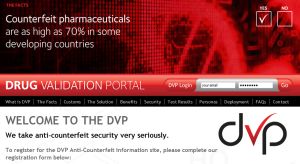 Johnson & Johnson subsidiary Janssen-Cilag has developed a new web-based tool that will make it easier for customs to check whether a suspect pharmaceutical shipment is fake or genuine.
Johnson & Johnson subsidiary Janssen-Cilag has developed a new web-based tool that will make it easier for customs to check whether a suspect pharmaceutical shipment is fake or genuine.
The Drug Validation Portal takes the form of a browser-based portal, accessible via a secure Internet site, which has been set up in close collaboration with customs officials and was road-tested last year by 17 customs officials in 10 EU countries.
Karl Boonen, executive director of healthcare solutions and business support at Janssen-Cilag, told SecuringPharma.com that the time is right for this tool because supply chain visibility in the pharmaceutical industry is generally poor and customs is the first line of defence against counterfeit medicines entering the EU.
"Customs want to check products for authenticity reliably, but are often hampered by lack of complete documentation from the rights holder and having to use a manual approach to detecting counterfeits," said Boonen.
In many cases, this involves the officer locating the correct paper-based file or binder and comparing a suspect product's packaging with a two-dimensional printout, which may not be kept up to date.
Janssen-Cilag will sometimes change product packaging every year, as this is in itself a protection against counterfeiting, but this makes it even more hard to ensure that all 27 EU customs authorities have up-to-date information.
The DVP portal overcomes that obstacle by making sure that all product packaging and shipping labels are available in a three-dimensional, 360-degree visualisation, accessible via a simple, visual interface, which is kept up-to-date by the rights holder.
The benefits are an increase in validation accuracy and efficiency, improved speed of the validation process and faster response times when suspicious goods are detected, as well as more effective communication between customs and rights holders, according to Boonen.
There is some work to be done for companies to generate the artwork and shipping information and to keep it up to date, but the system means that one upload of data provides instant coverage across Europe. It also means that the rights holder is informed immediately when a suspect package has been encountered, which means investigations can start sooner.
It takes a few minutes to a maximum of around half an hour to drill down to the individual product presentation, which is a lot shorter than the current process, according to Boonen.
Other initiatives are ongoing in Europe, including ProductGuard, a database of product and trademark information that has been developed by electronics group Philips and discussed with other companies across a number of industrial sectors.
This is a very good tool, according to Boonen, but is suffering from a 'chicken-and-egg' scenario at the moment, with industry waiting for European Commission backing on its use, and the EC waiting to see if companies are interested in using it as a single, cross-industry platform.
"It could take a couple of years at least before this initiative materialises," he said.
In the meantime, the DVP system has been presented to the European Federation of Pharmaceutical Industries & Associations (EFPIA) as well as the Pharmaceutical Security Institute (PSI) and Janssen-Cilag has been trying to encourage other drugmakers to join in with the project.
"We want to make sure that other companies do not duplicate this work and hope to position the DVP as a standard application for the pharmaceutical industry in Europe," said Boonen.
Commenting on the value of the system, Belgian customs officer Danny Struys, who was involved in the DVP pilot, said: "I cannot guarantee that we will check every single pharmaceutical consignment en route to its final destination."
"However, I can guarantee that if it is not included within the DVP, then that consignment will not be checked with the same degree of accuracy and confidence."
The first Janssen-Cilag products are already live in the system, which will be expanded to include additional products over the coming months. If that is successful, it may be possible to roll the system out beyond Europe and extend its coverage into other sectors such as fast-moving consumer goods as well.
A public version of the website which can be used to explore the functionality of the system is available at www.dvp-eu.com (registration required).
Empowering patients
Meanwhile Janssen-Cilag has also developed other ways to harness the Internet in the fight against counterfeits, including patient-orientated schemes.
The company has already set up an online verification system for its Priligy (dapoxetine) product, approved in a number of countries for the treatment of premature ejaculation, which allows customers to input a serial number found on the package and check whether their product is authentic.
"We acknowledge there will be a demand to buy Priligy over the Internet, regardless of the risks involved, so we wanted to at least provide a tool for a patient or pharmacist to check if the product in their hands is authentic," said Boonen.
Related articles:
UK updates counterfeit goods destruction law
FDA says PREDICT border control programme is delayed
EU launches consultation on customs enforcement of IPR
EU illicit trade in medicines could top €10.5bn, says survey
Dramatic rise in drug seizures by EU customs
©
SecuringIndustry.com




 Johnson & Johnson subsidiary Janssen-Cilag has developed a new web-based tool that will make it easier for customs to check whether a suspect pharmaceutical shipment is fake or genuine.
Johnson & Johnson subsidiary Janssen-Cilag has developed a new web-based tool that will make it easier for customs to check whether a suspect pharmaceutical shipment is fake or genuine.